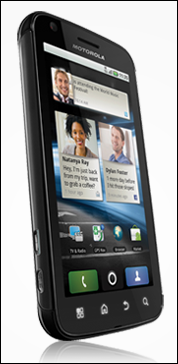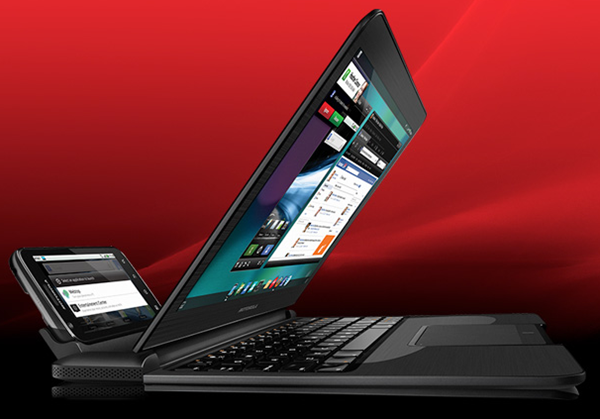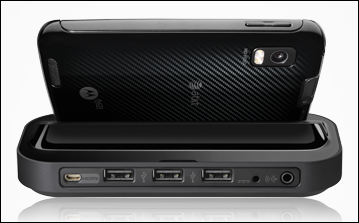 At this years CES, Motorola announced a number of devices. We saw their Xoom tablet that they’d been teasing prior to CES; we saw their latest Droid phone, the Bionic. But the coolest thing I saw from all of CES this year (not just from Motorola) was their upcoming Atrix smartphone.
At this years CES, Motorola announced a number of devices. We saw their Xoom tablet that they’d been teasing prior to CES; we saw their latest Droid phone, the Bionic. But the coolest thing I saw from all of CES this year (not just from Motorola) was their upcoming Atrix smartphone.
Chippy briefly wrote about the Atrix from the show floor, but it’s presence on our site was otherwise lost in the avalanche of news happening during those days. Now that the dust has settled, I can safely say that the Atrix represents something that I’m very excited about. Chippy called it “phone as a CPU inch and I think that’s a great analogy for it.
Motorola is calling the Atrix “the most powerful smartphone in the world inch, and it had better be as it aims to act as a companion device while you’re on the go, then dock on your desk at home for a desktop computing experience.
This idea isn’t new; those familiar with the ultra mobile PC category know about the advantages as an ultra portable device that’s also their desktop. Palm actually tried (well, tried to try) something similar with cellular devices back when they announced their Foleo, but it was widely criticized and eventually canceled. It seems, however, that we’re just starting to reach the point where the smartphone platform has become powerful enough to make this a reality. The Motorola Atrix is just one step in a longer path of truly ubiquitous personal computing, but we’re on our way soon and the experience will hopefully improve from this point on.
So before we talk too much what the Atrix represents, let’s look at the device itself. Here’s the official specs, straight from Motorola:
- Android 2.2
- 4 inch capacitive touchscreen @960×540
- NVIDIA Tegra 2 AP20H Dual Core CPU @ 1GHz
- 1GB of RAM
- 5MP auto-focus rear camera with dual-LED flash (capable of 720p recording)
- 0.3MP front facing camera
- 4G HSUPD speeds
A powerful phone no doubt, but also a low-powered computer. Stick it in the laptop dock to get a full keyboard, full screen, and desktop computing environment, complete with a fully functional Firefox browser (not the mobile version, this is legit Linux Firefox). There’s also an HD dock which can hook the phone up to any HDMI monitor or TV, and give you three USB ports for keyboard/mouse/etc. as well as audio output:
For more on the Atrix experience, have a look at Engadget’s video:
As you can see, the desktop experience certainly isn’t the fastest in the world, but beyond the device itself, the Atrix is representing an exciting push for ubiquitous personal computing, from one device, in the main stream and I cannot wait to find out where it leads us.
There’s obviously performance and battery life concerns with this sort of solution, but given the right speed and battery longevity, could this sort of phone-as-a-CPU computing paradigm work for you? Would it improve or stifle your work flow? We’d love to hear your thoughts in the comments.













the idea is very attractive and practical, i know for sure it won’t be perform powerful enough for full desktop activities, but it let you Salivate for the possibles.
for sure i am going to buy it :)
It seems to me a very stupid idea. Having 2 mobile devices (one tablet/netbook and one phone) seems so much more practical. This dock based solution makes your phone the single point of failure. What if the battery is empty, or you left your phone somewhere, or it was stolen or crashed? You’d be very happy if your bigger device isn’t just a dumb dock then…
And what would be the advantage of 2 devices in one? That you would never have to sync data? … If you don’t sync that also means that your data is lost when your device is lost. So I do not see why this idea is ever going to live up against the hype.
The phone is being charged while in the cradle of the laptop. What if your laptop was stolen….or for that matter, your brain.
This device can save you the data fees that a normal laptop/netbook incurs. Why is so difficult for people to wrap this idea around their heads.
Because it is a stupid idea.
What I don’t want is to rely on docking my phone for either to work.
Nor do I want a low low low powered system as a laptop or desktop. Geez just get a laptop or desktop.
Plus in “laptop” mode you have a phone + dock stuck to the back of it… hmmm great for computing on the go! Small laptops barely fit on plane tray tables as it is. Now if the phone fit into the device flush it might have been better.
It is a bad idea … Motorola just wanted to grab the headlines and they sure did. If you are suckered into thinking this is a great idea I feel for you.
I like the idea of using my hotel TV as a monitor while traveling… in fact, it gives me an idea… I can do that now with my Droid x or Galaxy tab and a bluetooth mouse and keyboard… I have all of this now…
Nice for some extended typing, or maybe a remote control session with Remote Desktop or logmein.com Ignition app…
I already left the PC at home while on my latest trip (nine days in Egypt) and had all this with me. This usage could make it even better…
ONLY question i havent seen asked is, why would other manufactures use it?
you make alot less money selling 1 device as the “brains” while all others are just dummy terminals, instead of each device being a full fledged phone/tablet/laptop.
H/Palm vision of every device being “smart” & syncing their status with the cloud for 1 cohesive experience is much more likely.
I tend to agree with this thought that a single system cuts against the business model used by most. I also think its difficult for a customer to step into this scene too as it requires quite an up-front investment.
I think the Atrix was among the coolest things I saw at CES. The others were the Samsung PC7 and the EEEPC Transformer. The problem is that while this devices represent a crossover and a potential multi-use scenario, they won’t yet satisfy 100% of the requirements of many users.
With the Atrix I see an indicator that something game-changing is happening in the market just like I saw with the Compaq Airlife from a year ago but its still the case that the processing power still isn’t at the level required for multi-task computing. Even netbooks are struggling with the web these days with html5, flash and huge memory requirements putting pressure on 1Gb dual-core Atom based devices. And then there’s the apps. Honeycomb won’t magically bring apps on day one. That is likely to take a year. ?Thematic is Android 2.x for the time being.
Another problem is the investment needed by the end user. Smartphone, spare battery, two docks and a bunch of cables of going to be getting close to $1000 in my opinion.
These devices could be good for hotel and holiday but I predict that most of us will stay staggered and multi-device in our approach to mobile computing, especially as prices come down. Expect Honeycomb dedicated 3g smart-books to reach sub $300 for example.
The Atrix has some amazing features but so does Nokia with USB otg, hdmi out and the big-screen application on the N8. So does the Samsung Galaxy Tab. So does the AC100 bit I’m not using any of these for productive internet work and I doubt many other people will be.
I have a post planned for crossover and modular devices planned soon.
Chippy (on the Tab at 0430 – excuse spelling problems please!)
One more thing. as Saheela said, I’m also salivating at the future possibilities. I love the idea of one personal processor and hope that It does happen but I think we’ll still be buying multiple devices for a while yet.
Good idea, poor implementation (regarding laptop dock). This isn’t gonna work, and here’s why: the phone sticks out like a sore thumb! I can see how it’ll cause problems in many scenarios, such as when you’re trying to use it on an airplane tray table.
If Motorola (or 3rd party) finds a way to create a laptop/netbook dock that lets you insert the phone like a PCMCIA card, then I’m sold.
I was thinking along the same lines, the phone sticking out the back seems a bit stupid. I would love to see the phone dock on the palm rest and become the trackpad.
Ditto this idea. Also I would suggest having some form of memory on the small laptop so you can backup documents every time you plug it in (if you want) – I would also like the laptop to have a DVD Writer (or even Blu-Ray) and a HD Ready screen (as a minimum)
I like this idea, one of my early thoughts was that viewable desktop area is precious, its a waste to not be able to use the display on the phone while docked.
Name could be difficult in Germany as it is a hand cream brand:
http://www.atrix-cream.com
For me the attraction is for corporate computing, as well as road-warriors.
In the office, most desks have a computer, laptop/docking station/monitor and a desk phone, plus a lot of people have a corporate mobile phone too, then this will replace all that with a corporate Atrix phone (got to have RIM-like management features to remote wipe/backup) and the netbook dock, maybe a second monitor with HDMI/DVI cable. They could Skype for landline calls and mobile for everything else. All the corporate apps would be delivered by the built-into-the-netbook dock Citrix client (not mentioned in the above post but is definitely there), and that could include the full MS Office suite if they’ve got the licences. The PC maintenance savings would be enormous on the netbook dock alone, all the thin client benefits are already built in.